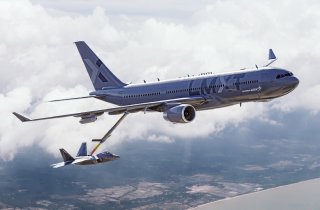Lockheed Martin's LMXT Could Be a Jobs Machine for Alabama and Georgia
The decision means that billions of dollars and thousands of manufacturing jobs will pour into local American economies.
The U.S. Air Force and Lockheed Martin have identified Mobile, Alabama, and Marietta, Georgia as manufacturing sites for the new LMXT KC-Y “Bridge Tanker” program.
The LMXT Bridge Tanker, while tailored to align with the Air Force’s need to deploy an interim tanker until the KC-46 arrives in large numbers, may itself be used by the Air Force for decades to come. The LMXT involves a partnership between Lockheed and the Airbus A330 Multi Role Tanker Transport, and this announcement ensures that the new aircraft will be American-made.
"Establishing this production work in Alabama and Georgia confirms Lockheed Martin's commitment that the LMXT will be built in America, by Americans, for Americans," said Lockheed Martin Chairman, President, and CEO James Taiclet. "The LMXT will strengthen global security by enabling our U.S. service members to carry out their most critical missions at extended ranges. At home, the LMXT will strengthen job growth and manufacturing by drawing on the experience and talents of a high-tech American workforce in two states that are proven leaders in aviation."
The decision means that billions of dollars and thousands of manufacturing jobs will likely pour into those local economies. In total, Lockheed’s programs in Georgia and Alabama will involve more than 630 suppliers, and the defense company reports that its overall economic impact across the two states totals more than $8.3 billion annually. Airbus has already been assembling commercial aircraft in Mobile since 2015, generating more than 15,000 jobs in the area.
It is expected that Airbus will leverage its commercial aviation expertise by building the planes, which will then be fully militarized by Lockheed at their facility in Georgia, where the company completes final production for its C-130J Hercules cargo aircraft.
“Lockheed Martin's Marietta facility has produced some of the most well-known military aircraft since 1951 to include every production C-130 Hercules (2,600-plus), the C-5 Galaxy/Super Galaxy, the P-3 Orion, the F-22 Raptor, and the C-141 Starlifter. More than 4,500 employees currently work at the site,” the Lockheed statement said.
The decision to base both production activities in the United States brings up an interesting and frequently discussed issue related to questions of “buying American.” Some are of the view that large weapons developers should, by and large, only “buy American.” However, others emphasize that such thinking should extend to incorporate a wide range of trusted American allies, in part because many of them bring jobs and business expertise to the United States.
Friendly foreign support for collaborative weapons programs is extremely crucial for both security and economic reasons, particularly given the growing strength of U.S. alliances with nations that are in positions to greatly impact the United States’ deterrence posture. For instance, Japan and European NATO allies completely change the deterrence equation when it comes to containing Russia or China.
Kris Osborn is the Defense Editor for the National Interest. Osborn previously served at the Pentagon as a Highly Qualified Expert with the Office of the Assistant Secretary of the Army—Acquisition, Logistics & Technology. Osborn has also worked as an anchor and on-air military specialist at national TV networks. He has appeared as a guest military expert on Fox News, MSNBC, The Military Channel, and The History Channel. He also has a Master's Degree in Comparative Literature from Columbia University.
Image: Reuters.

